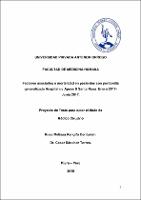| dc.contributor.advisor | Sánchez Torres, Cesar | |
| dc.contributor.author | Rengifo Centurión, Rosa Melissa | |
| dc.creator | Rengifo Centurión, Rosa Melissa | |
| dc.date.accessioned | 2018-10-12T14:31:36Z | |
| dc.date.available | 2018-10-12T14:31:36Z | |
| dc.date.issued | 2018 | |
| dc.identifier.uri | https://hdl.handle.net/20.500.12759/4387 | |
| dc.description.abstract | OBJETIVOS: Determinar los factores asociados a mortalidad en pacientes con
peritonitis generalizada Hospital de Apoyo II Santa Rosa Enero 2017- Junio
2017 y cuál de todos estos factores encontrado es el que con mayor
frecuencia se asocia a mortalidad en estos pacientes.
METODO: Se realizó un estudio descriptivo observacional , donde la población
de estudio estuvo constituida por todos los pacientes intervenidos
quirúrgicamente con diagnostico post operatorio de peritonitis secundaria
intervenidos quirúrgicamente en el Hospital de Apoyo II Santa Rosa Enero
2017- Junio 2017.
El universo y la muestra coincidieron, estando conformado por los 41 pacientes
que se hospitalizaron con diagnóstico de peritonitis secundaria en las unidades
de cirugía de dicho Hospital, en los que se cumplieron los criterios de inclusión
y exclusión. Se confeccionó una base de datos con las variables que se
analizaron en el estudio, que se obtuvieron de la ficha de vaciamiento a través
de los datos ofrecidos en la historia clínica del paciente. (Anexo I) Se elaboró
un fichero de datos con la utilización del programa Microsoft Excel, previo al
procesamiento de los mismos y la obtención de los resultados a través del
programa de análisis esta-dístico SPSS 18.0. En el análisis estadístico se hizo
uso de la prueba Chi Cuadrado (X2), mediante el sistema estadístico SPSS, se
calculó la chi2, las asociaciones fueron consideradas significativas si la
posibilidad de equivocarse fue menor al 5% (p < 0.05).El estudio contó con el
permiso del Comité de Investigación y Ética del Hospital de Apoyo II Santa
Rosa- Piura .Todas las historias con las que se trabajó contaban con
consentimiento informado de cirugía.
RESULTADOS:
Las variables que resultaron significativas y por tanto asociadas al riesgo de
morir fueron: Edad, el retardo quirúrgico , el índice de mannheim y las
comorbilidades asociadas.
CONCLUSIONES:
Los factores de riesgo asociados a mortalidad en pacientes con peritonitis por
perforación intestinal en el Hospital de Apoyo II Santa Rosa Enero 2017- Junio
2017,fueron la edad, la presencia de comorbilidad, el retardo quirúrgico, el
score de Mannheim. | es_PE |
| dc.description.abstract | OBJECTIVES: To determine the factors associated with mortality in patients
with generalized peritonitis Hospital support II Santa Rosa January 2017- June
2017 and who of all these factors was found to be most frequently associated
with mortality in these patients.
METHOD: An observational descriptive study was carried out, where the study
population consisted of all the patients who underwent surgery with a postoperative
diagnosis of secondary peritonitis surgically treated at the Hospital of Support II Santa Rosa January 2017-June 2017. The universe and the sample coincided, being made up of the 41 patients who
were hospitalized with a diagnosis of secondary peritonitis in the surgery units
of said hospital, which were completed with inclusion and exclusion criteria. A
database was made with the variables that were considered in the study, which
were obtained from the emptying sheet through the data offered in the patient's
medical history. (Annex I) We used a data file with the function of the Microsoft
Excel program, to process them and obtain the results through the statistical
analysis program SPSS 18.0. In the statistical analysis, the Chi square test was
used (X2), using the SPSS statistical system, the chi2 was calculated, the
associations were considered significant if the possibility of being wrong was
less than 5% (p <0.05). He had the permission of the Research and Ethics
Committee of the Support Hospital II Santa Rosa-Piura.
RESULTS:The variables that were significant and therefore associated with the
risk of dying were: : Age, surgical delay, mannheim index and associated
comorbidities.
CONCLUSIONS:The risk factors associated with mortality in patients with
intestinal perforation peritonitis at the Hospital of Support II Santa Rosa January
2017 to June 2017, were age, presence of comorbidity, surgical delay,
Mannheim score.
The main causes of secondary peritonitis were complicated acute appendicitis,
sigmoid volvulus and intestinal perforation. The main causes of comorbidity
were high blood pressure and DM2. The risk factors that had the greatest
influence on mortality were age and preoperative time. | en_US |
| dc.description.uri | Tesis | es_PE |
| dc.format | application/pdf | es_PE |
| dc.language.iso | spa | es_PE |
| dc.publisher | Universidad Privada Antenor Orrego - UPAO | es_PE |
| dc.relation.ispartofseries | T_MED.HUMAP_049 | |
| dc.rights | info:eu-repo/semantics/openAccess | es_PE |
| dc.source | Universidad Privada Antenor Orrego | es_PE |
| dc.source | Repositorio Institucional - UPAO | es_PE |
| dc.subject | Peritonitis | es_PE |
| dc.subject | Peritonitis secundaria | es_PE |
| dc.title | Factores asociados a mortalidad en pacientes con peritonitis generalizada Hospital de Apoyo II Santa Rosa Enero 2017- Junio 2017 | es_PE |
| dc.type | info:eu-repo/semantics/bachelorThesis | es_PE |
| thesis.degree.level | Título Profesional | es_PE |
| thesis.degree.grantor | Universidad Privada Antenor Orrego. Facultad de Medicina Humana | es_PE |
| thesis.degree.name | Médico Cirujano | es_PE |
| thesis.degree.discipline | Medicina Humana | es_PE |

